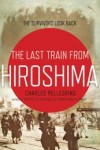Jigoku. The Japanese word for hell. Yet probably no concept of hell is sufficient to convey the paroxysm of the atomic bomb dropped on Hiroshima, Japan, on August 6, 1945. Perhaps equally difficult to imagine is being within a few blocks or or a couple miles of Ground Zero and surviving to escape the city — to go to Nagasaki, which would be struck by an even larger weapon three days later, and once again survive.
 Those double survivors are a significant motif of Charles Pellegrino’s The Last Train from Hiroshima: The Survivors Look Back. By chance released just two weeks after the death of one of its main subjects, Tsutomu Yamaguchi, the book tells the stories of many who experienced this hell on earth firsthand. They provide up close accounts of the bombings and their aftermath and illustrate how survival often hinged on the fortuity of just where they were at the time of the blast.
Those double survivors are a significant motif of Charles Pellegrino’s The Last Train from Hiroshima: The Survivors Look Back. By chance released just two weeks after the death of one of its main subjects, Tsutomu Yamaguchi, the book tells the stories of many who experienced this hell on earth firsthand. They provide up close accounts of the bombings and their aftermath and illustrate how survival often hinged on the fortuity of just where they were at the time of the blast.
Some of the most gripping moments in the book seek to help us envision the microseconds following the Hiroshima pika-don (“flash bang”). Pellegrino takes the reader to a home and Buddhist temple where a 35-year-old widow and approximately half a dozen monks were basically at Ground Zero, as well as those within a few hundred or thousand feet of the blast’s hypocenter. The book explains the physics and physiological effects in terms of millionths and thousandths of a second as the blast erupts and spreads, including the random chances that allowed some to survive while all around them were killed. In retrospect, the individuals at Ground Zero might be considered somewhat more fortunate than other victims. Pellegrino notes theirs were among the fastest deaths in history, their bodies ceasing to exist before their nerves could sense and transmit any pain.
Even as The Last Train from Hiroshima provides this atomic and cellular level delineation, it quickly takes a broader view. In fact, the book might try to encompass too many viewpoints. Unlike John Hersey’s highly-praised 1946 article/book Hiroshima, which looked at six survivors of the Hiroshima bombing, the number of people from both Hiroshima and Nagasaki whose stories Pellegrino tells can be a bit confusing. The focus on double survivors, which he estimates at around two dozen, helps. Still, it is at times difficult to keep all the of eyewitnesses straight, in part because some of their stories are kindred and in part because, as Pellegrino notes, many of the names are very similar.
Although Pellegrino introduces us to a number of double survivors, Yamaguchi is the only one officially recognized by the Japanese government as a double hibakusha, the term given survivors of the bombings. He was less than two miles from the Hiroshima explosion and, despite suffering serious burns on the left side of his body, worked to return by train to his home and family in Nagasaki. The Last Train from Hiroshima accompanies him on that journey and how, when he returned to work the day after his return, was again less than two miles from the world’s second Ground Zero. He was fortunate in more ways than one. The Mitsubishi plant at which he worked would have been Ground Zero had not cloud cover resulted in the larger Nagasaki bomb being dropped in a suburb.
The Last Train from Hiroshima looks at not only the immediate impact of the bombs but how they affected people, property and governments. The at times graphic descriptions can both appall and fascinate, such as how the eyeballs of some survivors were reshaped by the blast and eliminated their need for eyeglasses or the radiation caused one survivor’s cancer to go into remission. Although the book seems to serve as a voice of protest against such weapons, the content alone speaks far more eloquently toward that end. That is not the main focus, however, and Pellegrino also takes the reader inside the aircraft that flew the bombing missions and the decision-making of the Japanese government.
Written in a straightforward and readable style, the book takes a less journalistic tone than Hersey’s work. Which approach more effectively conveys the horror likely depends on the individual reader. Despite The Last Train from Hiroshima being much more of what might be termed popular history as opposed to Hersey’s reportage style, it will be interesting to compare the impact of both on their respective generations of readers. Hersey’s story first took up an entire issue of the New Yorker before being released as a book and, more recently, becoming the subject of a radio play. Thanks in part to their prior work together, movie director James Cameron has optioned the book for a possible film.
Hypocenters could be covered up with gardens and memorial structures, but visitors to the rebuilt cities would never understand or even be aware that there existed a spiritual wreckage.
Charles Pellegrino, The Last Train from Hiroshima







